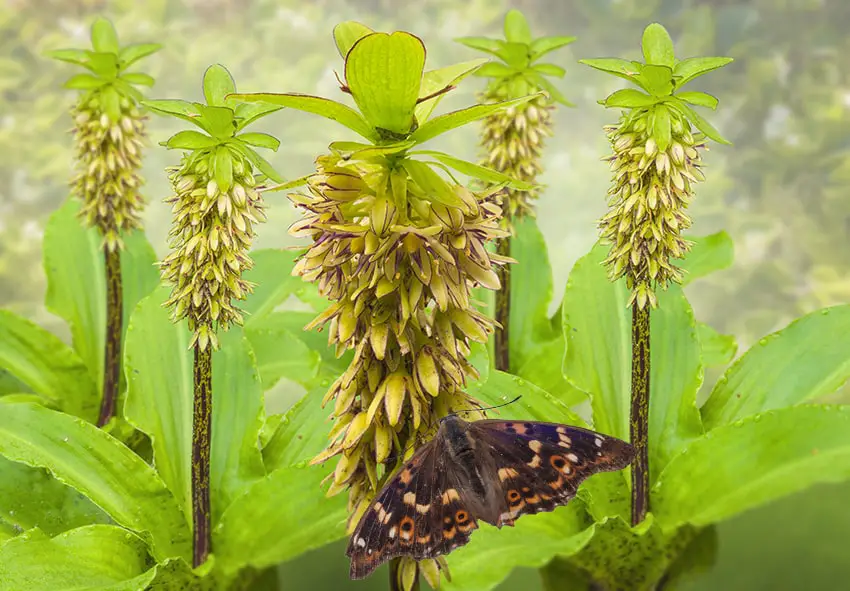
This unusual plant is called pineapple lily, but it is not a relative of lilies. What is it, does it happen, you will be surprised. Meet Eucomis or Eucomis, a relative of our snowdrops, pushkinia, origami, hyacinths and muscari, which have long settled in our gardens.

A flower with basal rosettes of lush leaves with stout stems.
The stems are covered with star-shaped flowers with a bunch of green bracts at the top.
They look a bit like a pineapple, hence the common name.
The scientific name of the genus, given by Charles Louis Lerit de Brutel in 1788, is derived from the Greek εῦκόμης – “one who has beautiful hair”, referring to the structure of the plant’s inflorescence.

Four species are grown in the culture, although there are 14 of them in the family. This handsome man is from South Africa. This immediately indicates the heat-loving nature of the plant, which needs to be dug up for the winter. It is possible that in the south of Ukraine, Eucomis overwinters in the open ground, but in the northern part of our country it will freeze in the open ground. Caring for this flower is similar to gladiolus (which are also of African origin) and dahlias. Also, this plant is grown as an indoor plant in a pot, but with a mandatory rest period.
Planting and caring for Eucomis
It is advisable to plant in open ground after the earth warms up and the threat of frost passes (similar to potatoes and gladiolus with dahlias) around April – May (you can plant before the Trinity).

But it is better to germinate eucomys in pots in about the second half of February or the beginning of March and carefully transplant them into the open ground in May-June. The bulbs should be planted shallowly for germination, 1/3 into the ground.
When planting in the garden, the bulb is slightly deepened so that its top is at ground level or even slightly higher.
The landing place must be prepared in advance. This is because the plant quickly forms a powerful, well-branched root system.
It is better for the plant to grow in the sun or in light, transparent penumbra. From the moment of planting until the beginning of active growth, watering should be minimal. Then, when the plant begins to grow quickly, it needs regular watering. It is advisable to fertilize with organic fertilizers once every two weeks. I use a solution of liquid universal fertilizer.
Eucomis blooms in July, for almost a month, depending on the size of the onion.
But even before flowering, the plant has a rather decorative appearance thanks to the bright dots on the lush rosettes of green leaves.

Storage of Eucomys bulbs
In the second half of September, together with dahlias and gladiolus, eucomys are dug up, shaken off the ground, washed in Maxim’s solution, dried and put in paper bags. Onions can be stored in the vegetable drawer of the refrigerator. You can also put it in a box with sawdust and leave it on the balcony, which is fully glazed and the temperature is always positive.
Types of eucomys
14 species grow in nature, but Eucomis bicolor and Eucomis autumnalis are the most popular in horticulture. Eucomis bicolor is called bicolor because the white-greenish flowers are framed by pink lines. The peduncle and leaves are also dotted with touches of purple.

Eucomis autumnalis (Eucomis autumnalis) is the lowest species, reaching a maximum height of 30 cm. The flowers are white or cream, flowering is later. It can withstand light frosts, which other species cannot.

This plant is very harmoniously combined with coleus.
Also against the background of such ground cover plants as alyssum or lobelia.
Eucomis companions should be small in height, requiring similar conditions. For example, like petunia, surfinia, cineraria, alyssum, carnation, cornflower.
It looks interesting in a rockery against the background of stones or near a pond.
Eucomis bulbs of the best quality, as well as lily and gladiolus bulbs, can be purchased in the Florium online store.
I hope that you will definitely try to grow such an interesting flower in your garden

Sincerely, experienced gardener, Olesya.
Read also Extraction of daffodils at home.
Published: 02.01.2020

2 thoughts on “Eucomis. Learn all about this plant”